CHAPTER XIX.
The Two-voice Canon, Accompanied. Instrumental.
200. This is by far the most practicable and valuable form of the Canon, because the added part (parte libera), or parts, disguise the constraint of the canonic imitation, and may contribute very significantly to the beauty and effectiveness of the whole. Any of the above canonic species may be thus treated, but the most common is that in the 8ve, parallel, — more rarely contrary.
201. The auxiliary (accompanying) part may be placed above, below, or between the canonic voices, at option; but much depends upon the degree of importance it assumes.
a. It may be distinctly subordinate (unessential), serving no other purpose than that of emphasizing the rhythm; or of supplementing the harmony where needed. For example:
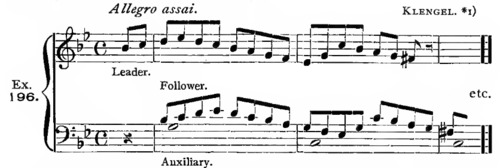
*1) Vol. II, Canon 16; 8ve, after one beat. Analyze to end.
Schumann, Studies for Pedal-piano, op. 56, No. 1; 8ve, after ½ measure; auxiliary Bass.
b. Or the auxiliary part may be coördinate with the canonic parts. In this case it may be a carefully conducted running voice (comp. par. 73b); or it may borrow its melodic and rhythmic figures from the Canon itself. For example:

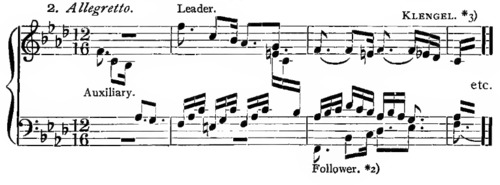
*1) Vol. I, Canon 18. Analyze.
*2) In Contrary motion, Tonic = Tonic (comp. par. 197).
*3) Vol. II, Canon 12. Analyze to end, and see also —
Klengel, Vol. I, Canon 8; Contrary motion (Dominant = Tonic), after one measure; auxiliary upper part, beginning in 3rd measure. — Vol. I, Canon 11; unison, after 2 beats; auxiliary Bass. — Vol. I, Canon 16; Contrary motion (Tonic = Tonic), after one measure; auxiliary Soprano, beginning in 2nd measure. — Vol. I, Canon 17; in the 2nd, after one measure; auxiliary Soprano, beginning in 8th measure. — Vol. II, Canon I; 8ve, after one measure; inner part a running auxiliary. — Vol. II, Fugue 6, middle Division; unison, after one measure, during Part I; running auxiliary Bass; in Part II the canonic voices appear in fairly exact contrary direction; Part III as before. — Vol. II, Canon 10; Double-8ve, after 2 measures; inner part auxiliary.—Vol. II, Canon 13; 8ve, after 2 measures; auxiliary Bass, beginning 2 measures before canonic parts. — Vol. II, Canon 15; 5th, after ½ measure; auxiliary Bass. — Vol. II, Canon 21; 5th, after one measure; auxiliary Bass.
Bach, Air with 30 Variations, Var. 3 (unison, after one measure, auxiliary Bass). Var. 6 (in 2nd, after one measure, auxiliary Bass; beautiful example). Var. 9 (in 6th, after one. measure, auxiliary Bass). Var. 12 (Contrary motion, Tonic = Dominant, after one measure, Bass partly coördinate). Var. 15 (ditto; Bass coördinate). Var. 18 (in 6th, after ½ measure, auxiliary Bass; fine example). Var. 21 (in 7th, after ½ measure, auxiliary Bass). Var. 24 (in 8ve, after 2 measures, auxiliary Bass).
Klengel, Vol. I, Canon 22, is in Augmentation, later Diminution (in 8ve), with auxiliary Bass; the canonic parts begin on first beat; the Augmentation, in inner part, extends to meas. 13½; Imitation in uniform rhythm follows (6-measure time-interval) to meas. 25½; then Diminution to end of meas. 28; then again Augmentation to meas. 35; then uniform Imitation (after 3 measures); in meas. 40 the time-interval is shortened to 2 measures; the Coda, last 3 measures, is in Diminution.
Sometimes two such coördinate parts accompany the 2-voice Canon. This is rare, however, excepting in the free harmonic manner shown in [par. 201]d below.
See Klengel, Vol. II, Canon 8; in 8ve, after one measure, two inner auxiliary parts. — Chadwick, Canonic Studies for Organ, op. 12, Canon 2; in 8ve, after 2 measures; two upper parts auxiliary.
c. Or the auxiliary part may be so conducted as to appear, as far as external effect is concerned, to constitute the essential element, which the canonic parts merely serve to sustain. Here the danger of incoherent or unintelligible form is greatly reduced. For example:


*1) Vol. I, Canon 7; analyze to end, and see also —
Vol. I, Canon 10; in 5th, after ½ measure; auxiliary upper part. — Vol. II, Canon 7; in 2nd, after two beats in 3-4 time; auxiliary Bass, beginning two measures before canonic parts.
d. Finally, the accompaniment may assume a distinctly harmonic character, imparting a more or less preponderantly homophonic effect to the whole.
It may be limited, as before, wholly (or largely) to one single auxiliary part, which exhibits the underlying harmony in broken-chord form (i.e., as harmonic figuration, in flowing rhythm). One of the canonic parts is almost certain to be given to the Soprano, the other to the inner voice, more rarely Bass. Thus:

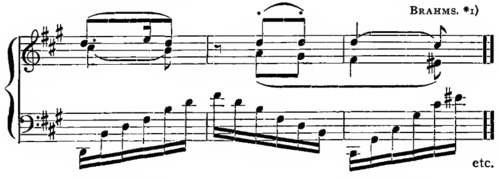
*1) Pfte. Variations, op. 9, Var. 14; Canon in the 2nd, after 2 measures. See also Var. 15; in 3rd, after one measure; auxiliary inner part. In both of these examples occasional, very slight, licences occur. — See further, Klengel, Vol. II, Canon 19; unison, after ½ measure; auxiliary Bass. —Vol. I, Canon 3; in the 4th, after 2 long measures; auxiliary Bass. — Vol. I, Canon 5; in the 7th, after one brief measure; auxiliary Bass, partly coördinate.
Or, the auxiliary homophonic accompaniment may consist in concrete harmonic bulk, with little (or no) regard to the number or continuity of parts (i.e., variable volume). Here, again, one of the canonic parts is assigned to the Soprano, almost without exception; the other may be placed in any lower part, but (unless in Bass) is frequently so confounded with the harmonic accompaniment as to be unrecognizable as a “canon.” See par. 202. For example:



*1) Pedal-piano Studies, op. 56, No. 2; Canon in unison, after one measure. Analyze; and see same work, No. 3; in 4th, after ½ measure; Prelude and Postlude added. — No. 5, in 8ve, after one measure; auxiliary accompaniment in inner parts and Bass; exquisite example.
*2) The Leader is in the Soprano; the Follower (8ve) in lower voice, in this broken form, throughout; an auxiliary Bass is added later.
*3) Pfte. Variations, op. 9, Var. 8; analyze carefully.
See also Ex. 201.
202. In order to appreciate the significance of the Canon-form, it should be contemplated in the abstract, aside from its uninviting mathematical aspect. As has been observed, each successive time-interval (one measure, or whatever section it may be) of the Leader is a counterpoint to the preceding section; that is, each such member is a product of the preceding one, through the strictest and most obvious process of logical derivation, or cumulation. The fact that the leading voice may thus accompany itself, may fit into itself, member by member, indicates a degree of cohesion and consistency of evolution which vindicates the rank of the Canon among those art-forms whose merit is founded upon close logic. This being the case, it is evident that the essential properties of the form are all present in the Leader alone, whether actually accompanied by the Follower or not; and though it might be injudicious ever to advocate the complete omission of the Follower,[*] it is interesting to question to what extent the presence of the Follower should be emphasized, — in other words, to what degree the canonic imitation should be made clearly recognizable. It is generally acknowledged that the merit of a Canon increases as the evidences of canonic labor decrease; that the more freely and naturally the leading voice runs, the more perfect the Canon; the less it betrays of its contrapuntal origin, the dry mathematical fact that one part is obstinately dogging the other, the better. Hence, the doctrine may be defensible, that a Canon need not be recognizable as such; but with one limitation, namely, not incessantly recognizable. The beauty and attractiveness of the act of Imitation, the calling of voice to voice, is so real, and so greatly appreciated by even the untutored musical listener, that it should not be banished from an art-form which, at its best, does not exhibit an excess of external beauty and grace. The proper balance between unimpassioned logic of structure on the one hand and romantic charm on the other, is most nearly achieved in the 8ve-Canon, with harmonic accompaniment, in which provision is made for clear formal arrangement, and for fairly frequent evidences of the canonic imitation. Review par. 192b.
203. When the last of the above varieties (par. 201d) is chosen, it is possible to mould the Canon in any of the Conventional styles of musical composition, as, for instance, the March, Minuet, Romanza, Étude, etc., etc. This is very desirable, as it lends definiteness of character and purpose to the Canon, and invites a certain legitimate freedom of treatment without violating any distinctive canonic condition (par. 186). For example:
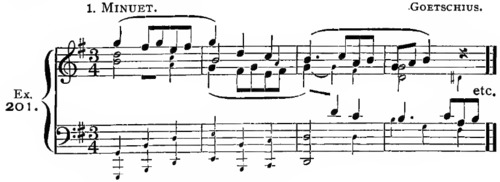
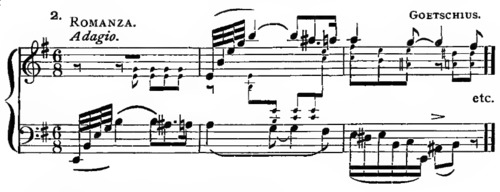
Additional miscellaneous illustrations:
Schumann, Jugend-Album, op. 68, No. 27 (in the 8ve); 3-Part Song-form; canonic voices exchanged in Part II. — Jugend-Sonata, op. 118, No. 2, second movement (8ve); 3-Part form, with all repetitions. — Albumblätter, op. 124, No. 20 (8ve). Symph. Études, op. 13, Étude 4 (8ve).
Guilmant, Org. Comp., op. 40, No. 3 (8ve).
Grieg, Lyric Pieces, op. 38, No. 8 (8ve).
Jadassohn, Pfte. Preludes and Fugues, op. 56; Prelude 2 (8ve). — Prel. 3 (8ve). — Prel. 6 and 8 (ditto).
Moszkowski, op. 15, No. 4.
Leschetizky, op. 36, No. 2 (Gigue); almost wholly unaccompanied.
Raff, Frühlingshoten, op. 55, No. 10.
Cesar Franck, Violin Sonata, A major, Finale; Sonata-allegro form, the Principal Theme each time an 8ve-Canon, in different modes of treatment.
G. W. Chadwick, Canonic Studies for Organ, op. 12; Nos. 1, 3, 4, 5, 6, 7, 8; different intervals; all accompanied.
EXERCISE 56.
A. An example of the 2-voice Canon, with subordinate auxiliary part (par. 201a). Any interval may be used.
B. A 2-voice Canon with coördinate auxiliary part (par. 201b). Any interval, or Contrary motion.
C. A 2-voice Canon with essential auxiliary part (par. 201c).
D. A number of Canons with harmonic accompaniment (par. 201d). For each, some conventional Style may be chosen (par. 203).
The Two-voice Canon, Accompanied: Vocal.
204. Among the conventional styles, frequently chosen for the outer vestment of the Canon, none is more effective than the vocal duet, with instrumental accompaniment.
The interval most commonly employed is the unison (when the voices are of similar register), or the octave (when parallel voices are used). But any interval is possible, and even Contrary motion is sometimes encountered. The time-interval is apt to be brief, as in the instrumental Canons.
The text is generally the same in both voices. The accompaniment is almost necessarily devoted, also, to an independent Prelude, occasional Interludes, and a Postlude; and, in general, it may assume considerable importance and independence of character. Sometimes the canonic Imitation extends to the end, but it is more common to add a free ending (par. 192d). For illustrations see —
Jadassohn, 9 Vocal Canons, op. 36. — 6 Vocal Canons, op. 38.
Henschel, 3 Vocal Canons, op. 4.
Mrs. H. H. A. Beach, Sea-Song for 2 Sopranos; in Part II the time-interval is enlarged; in Part III the voices are exchanged.
Haydn, 3rd (“Imperial”) Mass, Credo in unum Deum; Leader in Soprano and Tenor in 8ve-duplication, Follower (after one measure in the 4th) in Alto and Bass; although the complex thus embraces four voices, it is evidently only a 2-voice Canon
Brahms, Motet, op. 29, No. II, 3rd movement (in 2nd, accomp.).
EXERCISE 57.
A number of examples of the 2-voice Canon as vocal duet, with instrumental accompaniment.